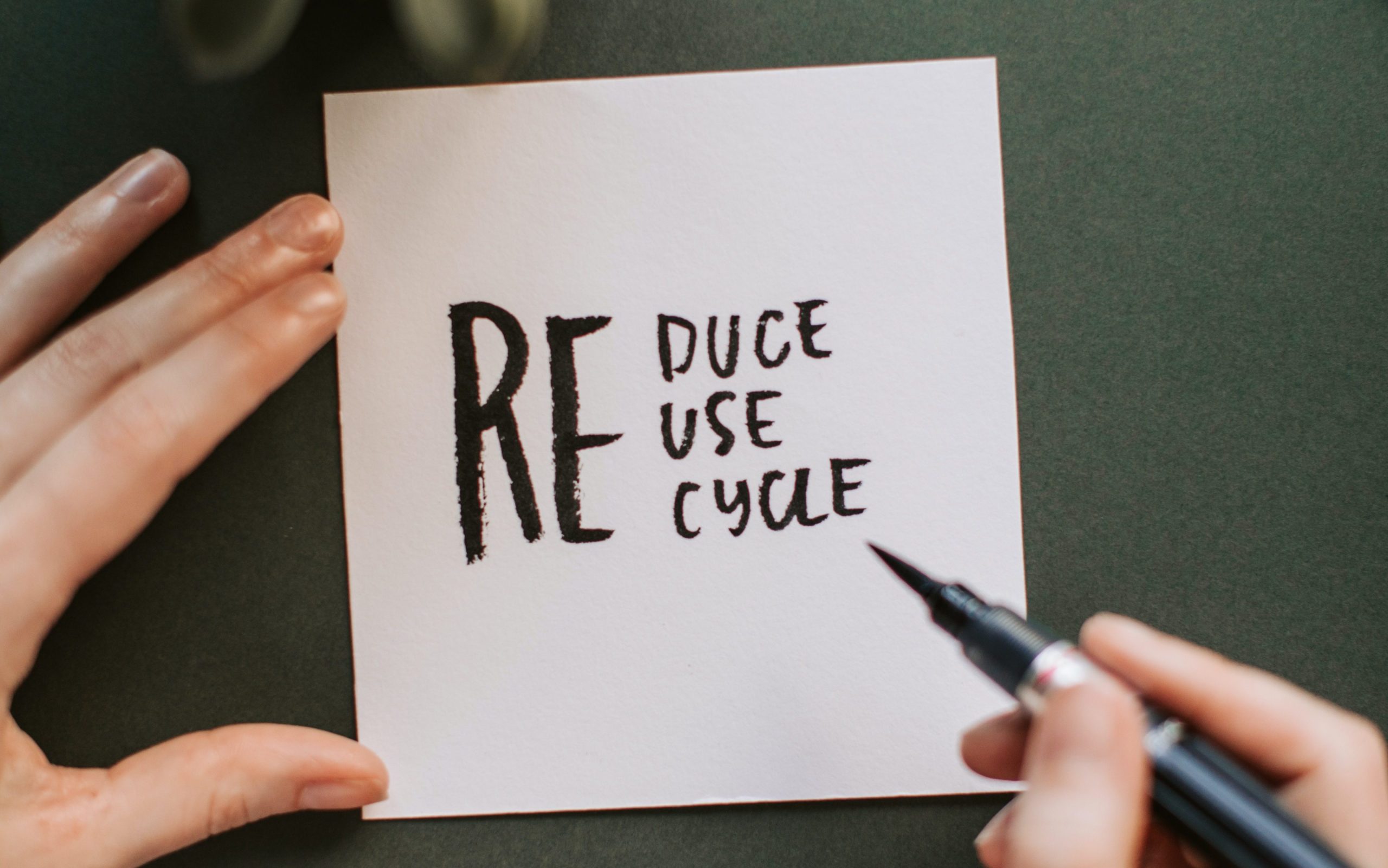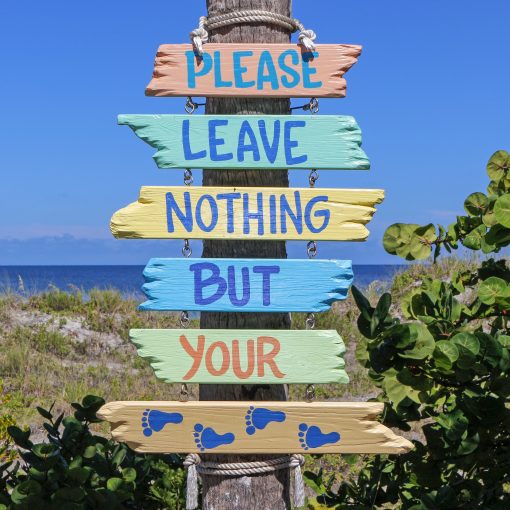
Origin of “The Three R’s”
“Reduce, Reuse, Recycle” was a saying that took off in the late 1970s shortly after the Environmental Protection Agency (EPA) was formed. Since then they worked in elementary school to instill “The Three R’s” with the iconic triangle of arrows.
As I grew older, I could easily have told you what “The Three R’s” were, but I never really thought more about it. That icon for reduce, reuse, recycle became the symbol for just recycling. After highschool, I got my own apartment and the trips to the recycling center began.

Revisiting this common phrase as an adult really changed my perspective. Children don’t have as much control over reducing and reusing in a household. I believe this led me to focus more on the recycling aspect as a way to help live a more sustainable life. Now that my husband and I make all of the purchasing decisions, I believe reducing and reusing should be the focus. Recycling should be done if reducing and reusing are not possible.
Closer look at each R
Reduce:
When they say reduce, the sentiment is to consume less. It stops the production of excess products. Creating an item takes natural resources and energy to produce, along with transporting it for distribution to get to you. You also stop those products from ending up in a landfill. This includes everything, from the coffee stir stick at Starbucks, to cheap toys, to the the newest iPhone.
Reuse:
Reuse is when you are able to extend the life of a current product for what it was originally intended or for something new. Reusing gives the items you no longer need a chance to live on before it is thrown or recycled. It can stop additional brand new products from being created.
Recycle:
Recycling is when a company will take the left over materials and attempt to reuse that in a new product. While it does introduces it back into production to be used again, there are additional resources that then go into making it into something new again.
How to Reduce?
Looking at “The three R’s” with new eyes, I place the most importance on reducing. I consider how I can lower my consumption. Most of the items I buy are replacing items that have broken or been used up. I also look for solutions that use less packaging where possible. For the past few years, I have put myself under “No Buys” for candles, lotions, and nail polishes because I knew I had enough product there to last me for years. This doesn’t mean that I do everything perfectly. That would be unrealistic. Trying to do everything 100% correct will only stress you out. Start with what you can and build out from there. I am still working on it every day.
Some ideas to try:
- Start your own “No Buy” Challenge
- Consider the full cost of the product to determine if it is worth it
- Invest in reusable options
- Purchase quality over quantity
- Research and consider all new purchases.
- Buy used items when possible.
- Limit travel, where possible
- Try to invest in companies that are taking steps in the right direction.
- Borrow out your tools to individuals you trust so they don’t need to purchase their own equipment for a one time use situation.
How to Reuse?
I find reusing tricky because my lifestyle involves looking to live with less. When a product is no longer useful to me, I will first consider if I can repurpose it in my own home. There are few instances when I can actually come up with a good reason to keep something. Reusing old towels for rags is one, but one can only have so many rags. If an object doesn’t have a purpose to me, I don’t want to look for excuses to keep it.
Recently, I have started looking at reusing in a different light, like repairing something broken. That could include paying for my cell phone to be fixed, even though I am up for an upgrade. Another example is fixing small tears in clothing or using some superglue on my favorite sunglasses.
If something can still be used by someone else, I consider selling it or donating it. Selling helps ensure it goes to someone who specifically was looking for that object. Donating can be a bit of a mixed bag on if it will be picked up by someone or if it will just end up in the trash. The benefit of donating is that if it does sell, the money typically go towards a charity. Reusing is often a time consuming task that takes a lot of planning and can be overwhelming, especially if you are decluttering your home. Because I struggle with this so much, it helps me be aware before even purchasing something new. “Will I feel guilty when I have to get rid of it later?”
Some ideas to try:
- Repair items when possible
- Repurpose old items for a new purpose.
- Sell to someone else
- Donate
How to recycle?
If your community has recycling, it is often limited on what they can accept. Companies put their recycling numbers on the plastics, so you have to ensure that type of plastic can be recycled in your area. Paper, grocery bags, lightbulbs, batteries, appliances, electronics all need to be dropped off at specific locations as well.
There are also misconceptions on what can be recycled in the first place. Pizza boxes are made of cardboard, but when soaked in pizza grease, the recycling company can’t use it because the cardboard is no longer usable for the recycling process. (Tip: If you do have a pizza box, take the top off the box and recycle that, throw away the bottom part of the box.) Many centers can’t take colored glass to be recycled, but that fact isn’t made very clear. Juice and milk cartons are marked with the recycle logo,but many recycling facilities do not take them.
In terms of electronic devices, many recycling facilities end up shipping that material over to other countries for the deconstruction process and sometimes in harmful environments for the workers.
Within the past few years, recycling facilities are finding it hard to sell their materials to manufacturing companies because they choose to make it from scratch. This discourages cities from doing recycling programs if they are unsure what they will be able to do with the recycled materials.
I used to deem recycling as the best way to be sustainable. Now it is still an important part, but it doesn’t address all the issues our planet is facing. I encourage recycling when you can as it is better than giving it no chance and ending up in a landfill or somewhere else it isn’t meant to be.
Some ideas to try:
- Use curbside recycling
- Go to your local drop off site for recycling.
- Some stores offer to recycle items that they sell.
Big Picture
This post has mainly focused on what we, ourselves, can do on a daily basis to have less of an environmental impact. I know from personal experience, that it can feel like you are doing it on your own and that what you are doing has little impact. I believe it is important to point out that we, as individuals, are not the only ones who can make changes. Companies can work to do the same.
For example, Patagonia, a clothing company, will take back their old clothing to either resell as used or to make into new clothing. They will even do repairs on their clothing so you can continue to wear it. This drastically cuts down on the new clothing they need to make and the new resources they need to consume. Isn’t it odd that it seems “out of the box” for Patagonia to have a link on their website on how the customer can fix their own clothes? They want their clothing to stand the test of time and prove it with different ways to extend the life of it.
Companies are not the only ones, but governments have many regulations and policies in place. Reviewing those and seeing if they help or hurt in terms of sustainability plays a big part in what companies can and can’t do. Talking with companies and diving deeper into how governments can help is something that I am very new with. I will continue to educate myself in this area.
Some ideas to try:
- Discuss concerns or recommendations you have within your own company with management if possible.
- Recommend or coordinate an event at your company or community focused on “reduce, reuse, recycle” to help bring attention to the issues.
- Write to companies you love on what you would like to see from them in the future and why it is important to you.
- Choose to buy from companies that are working toward what is important to you.
- Vote in local elections and if sustainability is a value you have, look for that value in the candidates.
You got this!
Trying to live sustainabily can feel like a lot of work at times. Especially when trying new ways to help. Always give yourself credit for the things you do already. I make small changes in my daily routine. I also look to other resources to learn more so I can make the best informed decisions I can. Hopefully revisiting the basics of reduce, reuse, recycle gave you something new to consider. Be kind to yourself and the planet.




